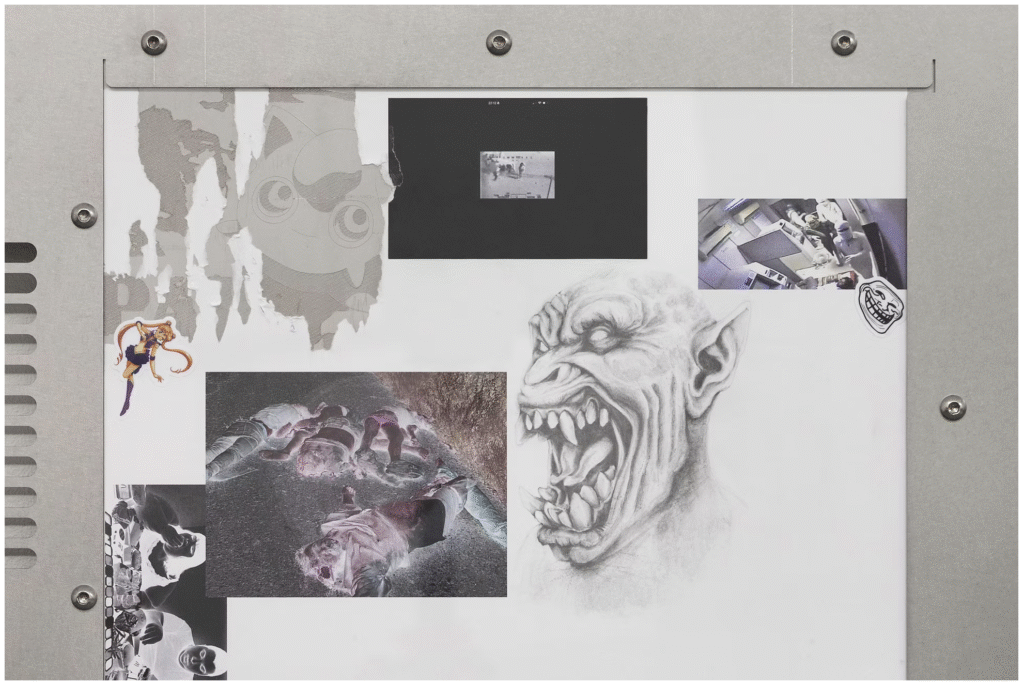Myths from Smoldering Skies explores the imaginary of a world in transition — a landscape suspended between destruction and rebirth, where a slow symbolic combustion opens the way to new possibilities of transformation. The exhibition brings together the practices of Jung Min Lee, Leilei Wu, Mattia Ragni and Sir Taki — four artists who, through distinct visual languages and conceptual frameworks, investigate reality as an archive of residual visions, where the time of ruin and that of myth converge. Through this dialogue between matter, image and memory, dystopian aesthetics evolve into a contemporary mythology, revealing the regenerative potential hidden within states of decline.
Jung Min Lee constructs post-apocalyptic worlds where vegetal, mechanical and human forms intertwine within cyclical processes of decay and regeneration. Her paintings function as post-organic ecosystems, depicting the remnants of humanity through a lens of nostalgia, as perceived by hybrid beings that emerge in the aftermath of human collapse. In the series Tipping Point (since 2025), Lee envisions a world devastated by war and radiation, traversed by a hybrid entity — part human, part plant. Earth Song (2025), titled after Michael Jackson’s 1995 anthem, follows this female figure as a post-apocalyptic bard who performs for a planet scarred by ecological catastrophe and conflict, seeking to restore life through music and vegetation. With the series 9999 Days (since 2023), Lee projects into a distant future where humanity has disappeared, supplanted by the Neoanthropinae or “Harpies” — post-human entities who act as custodians of memory. Longing for the vanished species that once resembled them, they trace the ruins of human civilization as both archaeologists and mourners. In Don’t Forget 9999, a Harpy with angelic features attempts to revive a fallen Humanoid, echoing religious iconography reframed within a speculative, futuristic context. Through this convergence of the archaic and the post-human, Lee meditates on extinction, metamorphosis and the endurance of myth as a framework for imagining futures beyond human time.
Leilei Wu’s artistic practice investigates the entanglement of technology, ecology and mythology through digital sculpture and hybrid installation. Her work inhabits a liminal zone where organic and synthetic elements converge, generating post-natural entities and landscapes in perpetual metamorphosis. By employing digital textures and translucent surfaces, Wu articulates a visual language that explores the porous boundaries between artificial systems and speculative ecologies.
For this exhibition, Wu presents a new series of luminous sculptural works that integrate LED technology into forms inspired by ancient museological artifacts. This juxtaposition between archaeological aesthetics and technological materiality generates a dialogue across temporal dimensions — between past and future, origin and simulation. The introduction of light reconfigures the traditional way of seeing, producing a volumetric spatial dimension in which light itself emerges as a perceptible form and structure. The resulting sculptures function as contemporary relics, where light operates not merely as illumination but as a symbolic and epistemic agent, transforming sculpture into a site of mediation between cultural memory and speculative imagination.

Sir Taki employs images as instruments of visual anthropology, constructing narratives that probe the complexity of human experience through associations and contrasts. Each work emerges from a process of juxtaposing and recomposing images — photographs, comics, paintings and archival materials — which the artist reworks digitally before translating them into various media: public installations, videos or prints. His practice explores the threshold between looking and seeing, confronting the viewer with cut, fragmented or dissonant visual combinations that invite reflection on the meanings generated by their relationships.
The works presented in the exhibition reflect this exploratory and relational approach. Some belong to ongoing projects in which the artist reinterprets the same subject through different techniques and exhibition contexts. Roberto, for instance, originated as a digital collage before becoming a mural painted in 2023 in Chiasso, while I Liberi?, a large site-specific paper installation created in the same city, is shown here in a reduced version, in dialogue with the gallery space. Through digital collage and the layering of visual languages, Sir Taki develops a method of synthesis and rewriting — a process in which heterogeneous fragments encounter one another to generate new meanings and new modes of perception.
Mattia Ragni’s Drift series explores the fragmented condition of the present through a visual language built on stratification and collision. His collages and laser-cut engravings on steel emerge from a process of collecting and reassembling visual fragments — drawings, stickers, consumer materials and residues of contemporary iconographic noise — which the artist transforms into intricate structures suspended between order and chaos. The resulting works constitute a visual archive where personal memories intersect with collective imagery, thus mapping the shifting geography of contemporary iconography. These steel constructions evoke modem-like devices, their drawn paper surfaces functioning as screens that contain dense, sci-fi microcosms. Within these rigid, almost scientific frameworks, speculative images unfold, generating tension between structure and imagination. Drift thus becomes an inquiry into the crisis of vision and the precarious status of the image within global capitalism — a meditation on an era where beauty and monstrosity persist in unstable equilibrium.
Across their distinct visual languages, Jung Min Lee, Leilei Wu, Mattia Ragni and Sir Taki engage critically with the circulation of images that define our contemporary visual horizon. Each artist reconfigures fragments drawn from popular culture, digital media and the visual archetypes of science fiction, transforming them into new symbolic constellations. In Myths from Smoldering Skies, their practices converge to reflect on the production and survival of images in an era of saturation and collapse. By appropriating, recomposing and transforming residues from contemporary visual culture, the artists activate new mythological narratives — hybrid, ambivalent and regenerative — that inhabit the liminal space between documentation and fiction, past and future. Within this shared terrain, image-making becomes an act of survival and reinvention: a way of reclaiming meaning from the smoldering debris of the present.
Available artworks
Via Rosolino Pilo, 14 – 20129, Milano
Tue–Fri 15.00–19.00
Via Rosolino Pilo, 14 – 20129, Milano
Tuesday – Saturday
11.00–13.00 14.30–19.00
info@limbo-contemporary.com
+39 351 328 8223